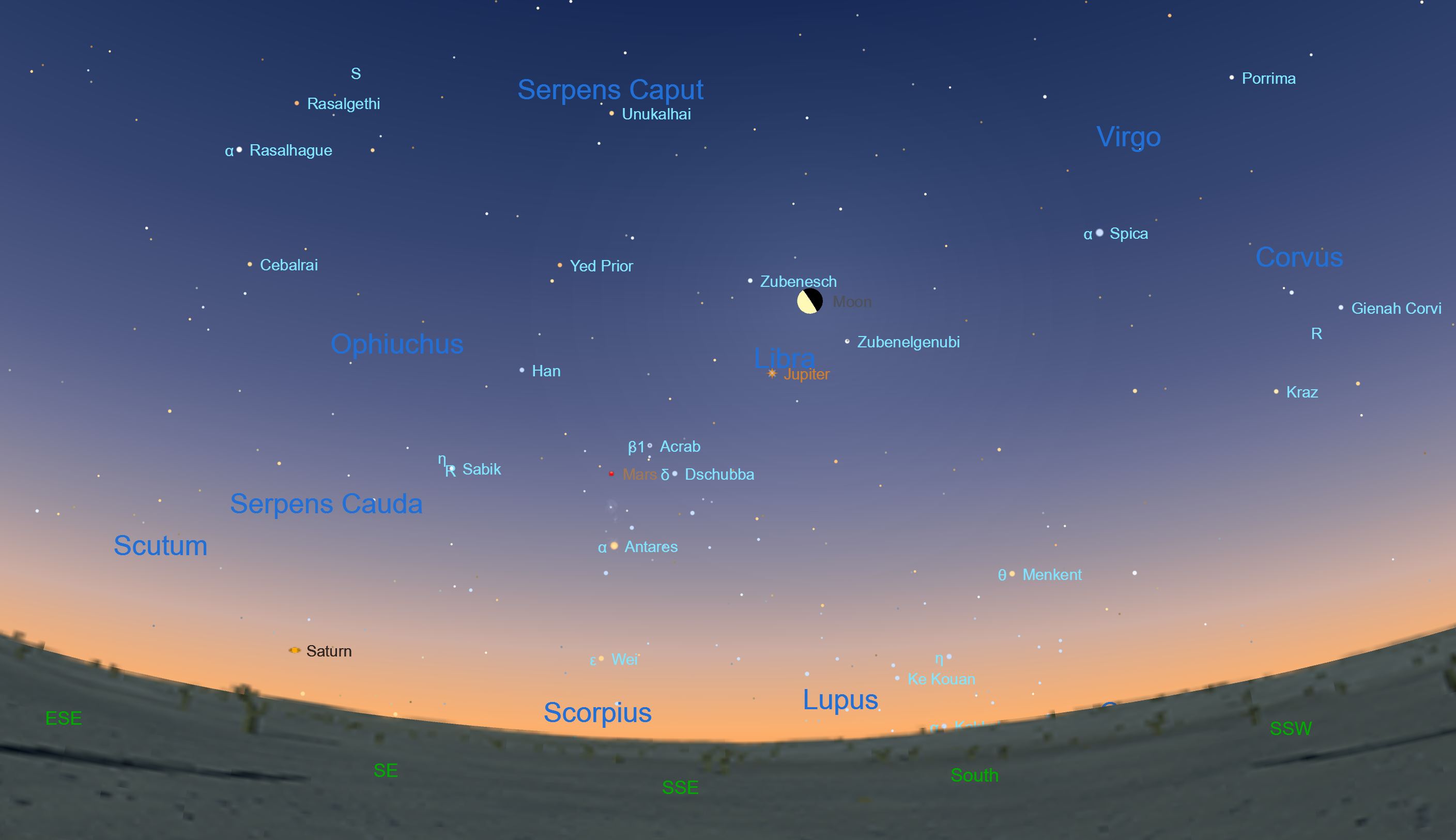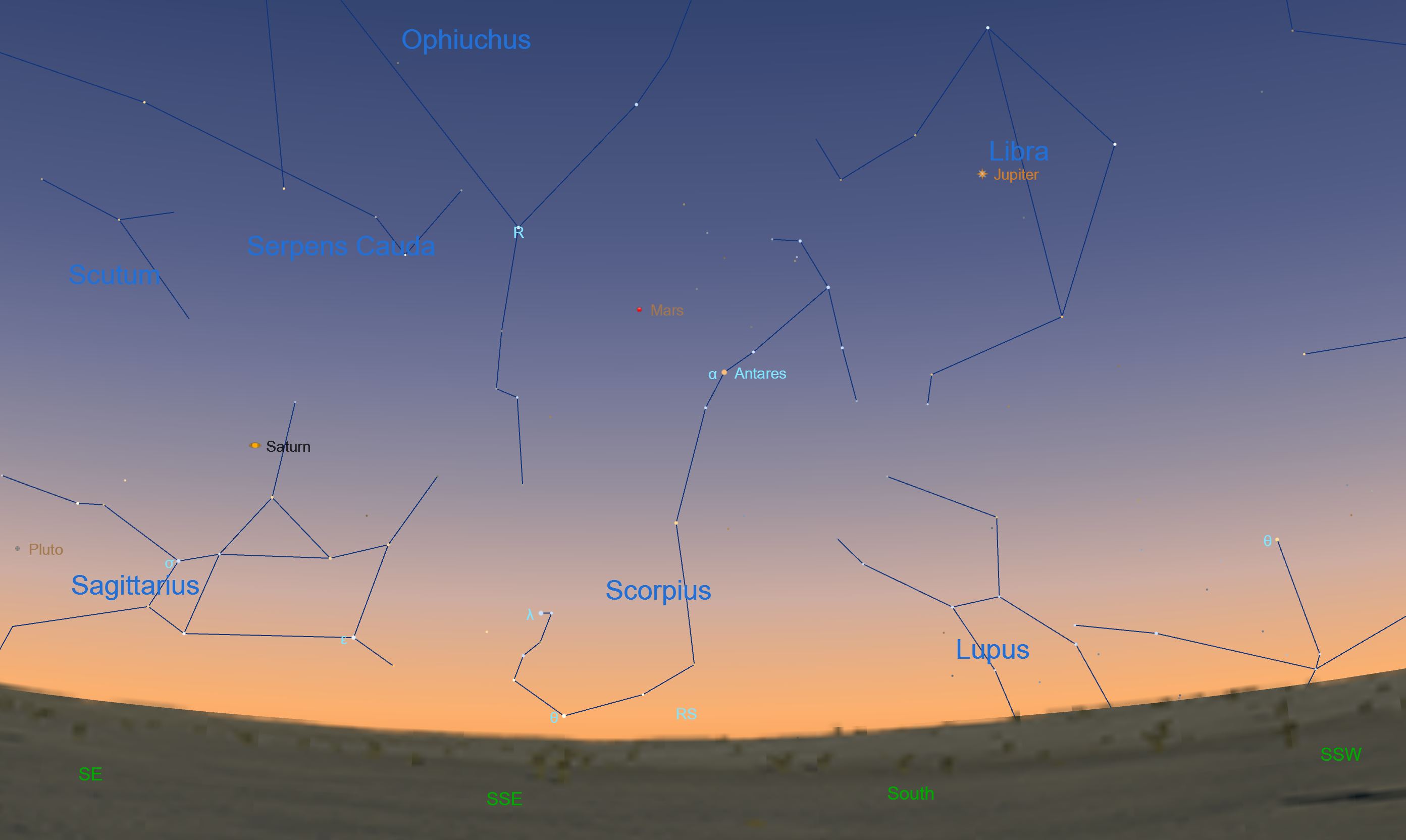The constellations Orion, Canis Major, Taurus, and Auriga dominate the northern sky this month, while southern observers see these same groups along with Puppis, Carina, and Vela, constellations which harbor some of the best sights the night sky has to offer. No matter where you live, grab a telescope or binoculars and head out to take a look. This February is also a slightly unusual month because there’s no full Moon. January had two, the last of which happened on the final day of the month along with a spectacular lunar eclipse that coincided with the Moon’s closest approach to Earth. The video above shows a splendid summary of the event made by Griffith Observatory in Los Angeles. And if you enjoyed waking early to see the planets Mars, Jupiter, and Saturn in January, then you’ll have even more fun this month as each slowly grows bigger and brighter in the pre-dawn sky. Here’s what to see in the night sky this month.
1 February 2018. The Moon, fresh off a spectacular eclipse, is just past full tonight under the ‘Sickle’ of the constellation Leo and just south and east of the bright first-magnitude star Regulus. Observers in northern Europe and Asia can see the Moon occult Regulus.
7 Feb. Look for Jupiter and the last quarter Moon in the early morning sky. Red-orange Mars lies to the east. Jupiter is growing in apparent size and brightness and is plenty close enough to reveal some detail in a telescope. It rises at about 2 a.m. as the month begins and near midnight as the month ends. The angle between the Sun, Earth, and Jupiter makes for some dramatic shadow transits cast by the planet’s four biggest moons.

7 Feb. Last Quarter Moon, 15:54 UT
8 Feb. The pre-dawn sky towards the east and southeast is a beautiful sight as Jupiter, a waning crescent Moon, and the slowly-brightening planet Mars gather among the stars of the constellations Scorpius and Libra.
10-17 Feb. Look for the zodiacal light in the west well after sunset. Very dark sky is a must. This tall, faint pyramid of white light is simply sunlight scattered off fine dust particles in the plane of the solar system. It’s sometimes called the ‘false dawn’ or the ‘false morning’.
11 Feb. Look for Mars once again in the southeastern pre-dawn sky as it moves within a few finger-widths of the bright star Antares. Both objects shine at about magnitude +1.0. Today, Mars is just to the north and east of the star. Antares, the brightest star in the constellation Scorpius, is in a sense named after Mars. Ant-Ares comes from the ancient Greek ‘compared to Ares’, and Ares is the Greek name for Mars, the Roman god of war. Antares itself is a stupendously large and bright star, swollen to a red supergiant, and it will one day explode as a supernova before fading and leaving the celestial Scorpion forever without a heart.

11 Feb. Look for Saturn situated between the waning crescent Moon and the top of the ‘Teapot” shape of Sagittarius. Saturn is re-emerging in the morning sky and is still too low and distant to reveal a good view in a telescope. But it’s one of the three bright planets now visible in the morning sky.
15 Feb. There’s a partial solar eclipse today. To see it, you will need to pack your bags and head south, way south, to the southern reaches of South America or Antarctica. The event comes, not by chance, two weeks after the fine lunar eclipse of Jan. 31 as the Moon crosses one of the nodes of its orbit, a point at which its orbital plane crosses the ecliptic.
15 Feb. New Moon, 21:05 UT
17 Feb. Venus returns to the evening sky this month! Today, the planet is about three finger widths above the horizon as the Sun sets and it’s joined by a beautiful and slender crescent Moon.

23 Feb. The Moon continues its eternal pilgrimage along the ecliptic. Now at first quarter, it rolls through the stars of the Hyades, the naked-eye star cluster that makes up much of the constellation Taurus. Observers in northeastern North America and much of Europe can see the Moon occult Aldebaran, the brightest star in Taurus.
23 Feb. First Quarter Moon, 15:54 UT
28 Feb – March 1. Yes, there’s another occultation tonight as the full Moon passes in front of the star Regulus in the eastern sky for observers in northern Canada and northern Europe. During the evening, spend some time watching the full Moon drift eastward ever closer to the star. Those out of the path of the occultation will see a very close approach.
Share This: